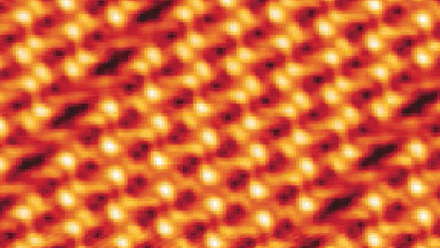The Problem
Two-dimensional metal borides have long been predicted to possess exceptional properties but have remained experimentally inaccessible due to the lack of a viable synthesis method.
Two-dimensional metal borides have long been predicted to possess exceptional properties but have remained experimentally inaccessible due to the lack of a viable synthesis method.
Researchers developed a synthesis technique that enables the formation of 2D copper boride by depositing atomic boron on copper surfaces at elevated temperatures.
This breakthrough opens the door to a new class of 2D materials with potential applications in energy storage, electronics, and next-generation computing technologies.
Professor Mark Hersam
Northwestern Engineering researchers have successfully synthesized two-dimensional (2D) copper boride, a new material with the potential to impact technologies in next-generation computing and energy storage. The discovery marks the experimental realization of a 2D metal boride, a class of materials that has primarily been limited to theoretical studies.

Crystalline structures just one or a few atoms thick, 2D materials are prized for their unique electronic, magnetic, and mechanical properties. While well-known examples such as graphene and borophene have been widely studied, 2D metal borides have largely remained out of reach due to longstanding challenges in synthesizing them.
This new work shows that copper boride can be produced by depositing atomic boron onto copper surfaces at high temperatures.
“Since this methodology can be applied on other metal surfaces, this work has the potential to accelerate the experimental realization of additional 2D metal borides,” said Mark Hersam, Walter P. Murphy Professor and Chair of the Department of Materials Science and Engineering at the McCormick School of Engineering, who led the research.
Hersam and his team reported their findings in the paper “Atomic-Resolution Structural and Spectroscopic Evidence for the Synthetic Realization of Two-Dimensional Copper Boride,” published May 23 in the journal Science Advances.
Mark HersamWalter P. Murphy Professor and Chair of the Department of Materials Science and Engineering
The research builds on the group’s earlier work developing borophene, a 2D form of boron synthesized by depositing atomic boron on silver. In that system, boron does not react with silver, resulting in an exclusively boron-based 2D material. Copper behaves differently.
“In contrast, due to the strong chemical interactions between boron and copper, the deposition of atomic boron on copper surfaces at an optimized substrate temperature leads to the formation of 2D copper boride,” Hersam said.
 By fine-tuning the deposition process, the researchers created a stable, atomically thin layer of copper boride. The approach offers a blueprint for creating similar materials by pairing boron with other metals.
By fine-tuning the deposition process, the researchers created a stable, atomically thin layer of copper boride. The approach offers a blueprint for creating similar materials by pairing boron with other metals.
Scientists have long believed that 2D metal borides could offer exceptional properties, including high electrical conductivity, tunable magnetism, and remarkable strength. Now that one has been successfully synthesized, those predictions can be tested in practice.
“The experimental synthesis of 2D copper boride allows its theoretically predicted properties and proposed applications to be experimentally explored,” Hersam said.
The team now plans to expand this technique to explore other 2D metal borides and to investigate how these materials might perform in real-world technologies. This future work includes testing 2D copper boride in proposed applications ranging from high-performance computing to advanced energy systems.